Identification and Characterization of Malate Dehydrogenases in Tomato (Solanum lycopersicum L.)
Abstract
1. Introduction
2. Results
2.1. Identification and Characterization of MDHs in Tomato
2.2. Chromosomal Localization and Duplication Analysis of MDH Genes
2.3. Phylogenetic Analysis, Conserved Motifs, and Gene Structure Analysis of MDHs
2.4. Putative Cis-elements in the Promoter Regions of MDHs
2.5. Expression Analysis of SlMDH Genes in Different Tissues and at Various Stages of Fruit Development
2.6. SlMDH Genes Expression in Response to Heat, Drought, and Salinity Stress
2.7. MDH Quantitative Expression under Salinity Stress
2.8. Molecular Docking of SlMDH
2.9. Co-Localization of MDH Genes with the Salt Stress-Related QTLs
3. Discussion
4. Materials and Methods
4.1. Identification of MDH Proteins
4.2. Synteny and Collinearity Analysis
4.3. Sequence Alignment and Phylogenetic Analysis
4.4. Structure and Conserved Motif Analysis of MDHs
4.5. Promoter Analysis of SlMDH Genes
4.6. Transcriptomic Data Analysis of MDH Genes
4.7. Plant Growth and Treatments
4.8. RNA Isolation, and qRT-PCR Analysis
4.9. MDH Genes Localization with Salt Tolerance Related QTLs
4.10. Molecular Docking
Supplementary Materials
Author Contributions
Funding
Conflicts of Interest
References
- Fernie, A.R.; Martinoia, E. Malate. Jack of all trades or master of a few? Phytochemistry 2009, 70, 828–832. [Google Scholar] [CrossRef] [PubMed]
- Ocheretina, O.; Scheibe, R. Cloning and sequence analysis of cDNAs encoding plant cytosolic malate dehydrogenase. Gene 1997, 199, 145–148. [Google Scholar] [CrossRef]
- Kromer, S. Respiration during photosynthesis. Annu. Rev. Plant Biol. 1995, 46, 45–70. [Google Scholar] [CrossRef]
- Hall, M.D.; Levitt, D.G.; Banaszak, L.J. Crystal structure of Escherichia coli malate dehydrogenase: A complex of the apoenzyme and citrate at 1· 87 Å resolution. J. Mol. Biol. 1992, 226, 867–882. [Google Scholar] [CrossRef]
- Minarik, P.; Tomaskova, N.; Kollarova, M.; Antalik, M. Malate dehydrogenases-structure and function. Gen. Physiol. Biophys. 2002, 21, 257–266. [Google Scholar]
- Imran, M.; Tang, K.; Liu, J.-Y. Comparative genome-wide analysis of the malate dehydrogenase gene families in cotton. PLoS ONE 2016, 11, e0166341. [Google Scholar] [CrossRef][Green Version]
- Hatch, M.; Slack, C. NADP-specific malate dehydrogenase and glycerate kinase in leaves and evidence for their location in chloroplasts. Biochem. Biophys. Res. Commun. 1969, 34, 589–593. [Google Scholar] [CrossRef]
- Kandoi, D.; Mohanty, S.; Tripathy, B.C. Overexpression of plastidic maize NADP-malate dehydrogenase (ZmNADP-MDH) in Arabidopsis thaliana confers tolerance to salt stress. Protoplasma 2018, 255, 547–563. [Google Scholar] [CrossRef]
- Fernie, A.R.; Carrari, F.; Sweetlove, L.J. Respiratory metabolism: Glycolysis, the TCA cycle and mitochondrial electron transport. Curr. Opin. Plant Biol. 2004, 7, 254–261. [Google Scholar] [CrossRef]
- Imran, M.; Liu, J.-Y. Genome-wide identification and expression analysis of the malate dehydrogenase gene family in Gossypium arboreum. Pak. J. Bot 2016, 48, 1081–1090. [Google Scholar]
- Imran, M.; Zhang, B.; Tang, K.; Liu, J. Molecular characterization of a cytosolic malate dehydrogenase gene (GhcMDH1) from cotton. Chem. Res. Chin. Univ. 2017, 33, 87–93. [Google Scholar] [CrossRef]
- Ding, Y.; Ma, Q.-H. Characterization of a cytosolic malate dehydrogenase cDNA which encodes an isozyme toward oxaloacetate reduction in wheat. Biochimie 2004, 86, 509–518. [Google Scholar] [CrossRef] [PubMed]
- Wang, Q.J.; Sun, H.; Dong, Q.L.; Sun, T.Y.; Jin, Z.X.; Hao, Y.J.; Yao, Y.X. The enhancement of tolerance to salt and cold stresses by modifying the redox state and salicylic acid content via the cytosolic malate dehydrogenase gene in transgenic apple plants. Plant Biotechnol. J. 2016, 14, 1986–1997. [Google Scholar] [CrossRef]
- Yao, Y.-X.; Dong, Q.-L.; Zhai, H.; You, C.-X.; Hao, Y.-J. The functions of an apple cytosolic malate dehydrogenase gene in growth and tolerance to cold and salt stresses. Plant Physiol. Biochem. 2011, 49, 257–264. [Google Scholar] [CrossRef] [PubMed]
- Beeler, S.; Liu, H.-C.; Stadler, M.; Schreier, T.; Eicke, S.; Lue, W.-L.; Truernit, E.; Zeeman, S.C.; Chen, J.; Kötting, O. Plastidial NAD-dependent malate dehydrogenase is critical for embryo development and heterotrophic metabolism in Arabidopsis. Plant Physiol. 2014, 164, 1175–1190. [Google Scholar] [CrossRef]
- Selinski, J.; König, N.; Wellmeyer, B.; Hanke, G.T.; Linke, V.; Neuhaus, H.E.; Scheibe, R. The plastid-localized NAD-dependent malate dehydrogenase is crucial for energy homeostasis in developing Arabidopsis thaliana seeds. Mol. Plant 2014, 7, 170–186. [Google Scholar] [CrossRef]
- Sew, Y.S.; Ströher, E.; Fenske, R.; Millar, A.H. Loss of mitochondrial malate dehydrogenase activity alters seed metabolism impairing seed maturation and post-germination growth in Arabidopsis. Plant Physiol. 2016, 171, 849–863. [Google Scholar]
- Gerszberg, A.; Hnatuszko-Konka, K.; Kowalczyk, T.; Kononowicz, A.K. Tomato (Solanum lycopersicum L.) in the service of biotechnology. Plant Cell Tissue Organ Cult. PCTOC 2015, 120, 881–902. [Google Scholar] [CrossRef]
- Van der Hoeven, R.; Ronning, C.; Giovannoni, J.; Martin, G.; Tanksley, S. Deductions about the number, organization, and evolution of genes in the tomato genome based on analysis of a large expressed sequence tag collection and selective genomic sequencing. Plant Cell 2002, 14, 1441–1456. [Google Scholar] [CrossRef]
- Barone, A.; Chiusano, M.L.; Ercolano, M.R.; Giuliano, G.; Grandillo, S.; Frusciante, L. Structural and functional genomics of tomato. Int. J. Plant Genom. 2008, 2008, 1–12. [Google Scholar] [CrossRef]
- Michaelson, M.J.; Price, H.J.; Ellison, J.R.; Johnston, J.S. Comparison of plant DNA contents determined by Feulgen microspectrophotometry and laser flow cytometry. Am. J. Bot. 1991, 78, 183–188. [Google Scholar] [CrossRef]
- Tomato Genome Consortium, X. The tomato genome sequence provides insights into fleshy fruit evolution. Nature 2012, 485, 635. [Google Scholar] [CrossRef]
- Nan, N.; Wang, J.; Shi, Y.; Qian, Y.; Jiang, L.; Huang, S.; Liu, Y.; Wu, Y.; Liu, B.; Xu, Z.Y. Rice plastidial NAD-dependent malate dehydrogenase 1 negatively regulates salt stress response by reducing the vitamin B6 content. Plant Biotechnol. J. 2020, 18, 172–184. [Google Scholar] [CrossRef] [PubMed]
- Chen, X.; Zhang, J.; Zhang, C.; Wang, S.; Yang, M. Genome-wide investigation of malate dehydrogenase gene family in poplar (Populus trichocarpa) and their expression analysis under salt stress. Acta Physiol. Plant. 2021, 43, 28. [Google Scholar] [CrossRef]
- Cronn, R.C.; Small, R.L.; Wendel, J.F. Duplicated genes evolve independently after polyploid formation in cotton. Proc. Natl. Acad. Sci. USA 1999, 96, 14406–14411. [Google Scholar] [CrossRef]
- Chi, Y.; Cheng, Y.; Vanitha, J.; Kumar, N.; Ramamoorthy, R.; Ramachandran, S.; Jiang, S.-Y. Expansion mechanisms and functional divergence of the glutathione S-transferase family in sorghum and other higher plants. DNA Res. 2011, 18, 1–16. [Google Scholar] [CrossRef]
- Nekrutenko, A.; Makova, K.D.; Li, W.-H. The KA/KS ratio test for assessing the protein-coding potential of genomic regions: An empirical and simulation study. Genome Res. 2002, 12, 198–202. [Google Scholar] [CrossRef] [PubMed]
- Foolad, M.R.; Zhang, L.; Lin, G. Identification and validation of QTLs for salt tolerance during vegetative growth in tomato by selective genotyping. Genome 2001, 44, 444–454. [Google Scholar] [CrossRef]
- Villalta, I.; Reina-Sánchez, A.; Bolarín, M.; Cuartero, J.; Belver, A.; Venema, K.; Carbonell, E.; Asins, M. Genetic analysis of Na+ and K+ concentrations in leaf and stem as physiological components of salt tolerance in tomato. Theor. Appl. Genet. 2008, 116, 869–880. [Google Scholar] [CrossRef]
- Asins, M.J.; Villalta, I.; Aly, M.M.; Olias, R.; Álvarez De Morales, P.; Huertas, R.; Li, J.; JAIME-PÉREZ, N.; Haro, R.; Raga, V. Two closely linked tomato HKT coding genes are positional candidates for the major tomato QTL involved in Na+/K+ homeostasis. Plant Cell Environ. 2013, 36, 1171–1191. [Google Scholar] [CrossRef]
- Diouf, I.A.; Derivot, L.; Bitton, F.; Pascual, L.; Causse, M. Water deficit and salinity stress reveal many specific QTL for plant growth and fruit quality traits in tomato. Front. Plant Sci. 2018, 9, 279. [Google Scholar] [CrossRef] [PubMed]
- Bai, Y.; Kissoudis, C.; Yan, Z.; Visser, R.G.; van der Linden, G. Plant behaviour under combined stress: Tomato responses to combined salinity and pathogen stress. Plant J. 2018, 93, 781–793. [Google Scholar] [CrossRef] [PubMed]
- Tesfaye, M.; Temple, S.J.; Allan, D.L.; Vance, C.P.; Samac, D.A. Overexpression of malate dehydrogenase in transgenic alfalfa enhances organic acid synthesis and confers tolerance to aluminum. Plant Physiol. 2001, 127, 1836–1844. [Google Scholar] [CrossRef] [PubMed]
- Metzler, M.C.; Rothermel, B.A.; Nelson, T. Maize NADP-malate dehydrogenase: cDNA cloning, sequence, and mRNA characterization. Plant Mol. Biol. 1989, 12, 713–722. [Google Scholar] [CrossRef] [PubMed]
- Sweetman, C.; Deluc, L.G.; Cramer, G.R.; Ford, C.M.; Soole, K.L. Regulation of malate metabolism in grape berry and other developing fruits. Phytochemistry 2009, 70, 1329–1344. [Google Scholar] [CrossRef]
- Hannenhalli, S.S.; Russell, R.B. Analysis and prediction of functional sub-types from protein sequence alignments. J. Mol. Biol. 2000, 303, 61–76. [Google Scholar] [CrossRef]
- Ren, X.-Y.; Vorst, O.; Fiers, M.W.; Stiekema, W.J.; Nap, J.-P. In plants, highly expressed genes are the least compact. Trends Genet. 2006, 22, 528–532. [Google Scholar] [CrossRef]
- Kong, H.; Landherr, L.L.; Frohlich, M.W.; Leebens-Mack, J.; Ma, H.; DePamphilis, C.W. Patterns of gene duplication in the plant SKP1 gene family in angiosperms: Evidence for multiple mechanisms of rapid gene birth. Plant J. 2007, 50, 873–885. [Google Scholar] [CrossRef]
- Dey, P.; Brownleader, M.; Harborne, J. Molecular components. Plant Biochem. 1997, 1, 50002–50003. [Google Scholar]
- Song, Y.; Feng, L.; Alyafei, M.A.M.; Jaleel, A.; Ren, M. Function of Chloroplasts in Plant Stress Responses. Int. J. Mol. Sci. 2021, 22, 13464. [Google Scholar] [CrossRef]
- Goodstein, D.M.; Shu, S.; Howson, R.; Neupane, R.; Hayes, R.D.; Fazo, J.; Mitros, T.; Dirks, W.; Hellsten, U.; Putnam, N. Phytozome: A comparative platform for green plant genomics. Nucleic Acids Res. 2012, 40, D1178–D1186. [Google Scholar] [CrossRef] [PubMed]
- Altschul, S.F.; Madden, T.L.; Schäffer, A.A.; Zhang, J.; Zhang, Z.; Miller, W.; Lipman, D.J. Gapped BLAST and PSI-BLAST: A new generation of protein database search programs. Nucleic Acids Res. 1997, 25, 3389–3402. [Google Scholar] [CrossRef]
- Quevillon, E.; Silventoinen, V.; Pillai, S.; Harte, N.; Mulder, N.; Apweiler, R.; Lopez, R. InterProScan: Protein domains identifier. Nucleic Acids Res. 2005, 33, W116–W120. [Google Scholar] [CrossRef] [PubMed]
- Schultz, J.; Milpetz, F.; Bork, P.; Ponting, C.P. SMART, a simple modular architecture research tool: Identification of signaling domains. Proc. Natl. Acad. Sci. USA 1998, 95, 5857–5864. [Google Scholar] [CrossRef] [PubMed]
- Gasteiger, E.; Hoogland, C.; Gattiker, A.; Wilkins, M.R.; Appel, R.D.; Bairoch, A. Protein identification and analysis tools on the ExPASy server. Proteom. Protoc. Handb. 2005, 2005, 571–607. [Google Scholar]
- Horton, P.; Park, K.-J.; Obayashi, T.; Fujita, N.; Harada, H.; Adams-Collier, C.; Nakai, K. WoLF PSORT: Protein localization predictor. Nucleic Acids Res. 2007, 35, W585–W587. [Google Scholar] [CrossRef]
- Chen, C.; Chen, H.; Zhang, Y.; Thomas, H.R.; Frank, M.H.; He, Y.; Xia, R. TBtools: An integrative toolkit developed for interactive analyses of big biological data. Mol. Plant 2020, 13, 1194–1202. [Google Scholar] [CrossRef]
- Tamura, K.; Peterson, D.; Peterson, N.; Stecher, G.; Nei, M.; Kumar, S. MEGA5: Molecular evolutionary genetics analysis using maximum likelihood, evolutionary distance, and maximum parsimony methods. Mol. Biol. Evol. 2011, 28, 2731–2739. [Google Scholar] [CrossRef]
- Guo, A.-Y.; Zhu, Q.-H.; Chen, X.; Luo, J.-C. GSDS: A gene structure display server. Yi Chuan 2007, 29, 1023–1026. [Google Scholar] [CrossRef]
- Bailey, T.L.; Williams, N.; Misleh, C.; Li, W.W. MEME: Discovering and analyzing DNA and protein sequence motifs. Nucleic Acids Res. 2006, 34, W369–W373. [Google Scholar] [CrossRef]
- Lescot, M.; Déhais, P.; Thijs, G.; Marchal, K.; Moreau, Y.; Van de Peer, Y.; Rouzé, P.; Rombauts, S. PlantCARE, a database of plant cis-acting regulatory elements and a portal to tools for in silico analysis of promoter sequences. Nucleic Acids Res. 2002, 30, 325–327. [Google Scholar] [CrossRef] [PubMed]
- Fei, Z.; Joung, J.-G.; Tang, X.; Zheng, Y.; Huang, M.; Lee, J.M.; McQuinn, R.; Tieman, D.M.; Alba, R.; Klee, H.J. Tomato Functional Genomics Database: A comprehensive resource and analysis package for tomato functional genomics. Nucleic Acids Res. 2010, 39, D1156–D1163. [Google Scholar] [CrossRef]
- Hoagland, D.R.; Arnon, D.I. The Water-Culture Method for Growing Plants without Soil. Circ. Calif. Agric. Exp. Stn. 1950, 347, 32. [Google Scholar]
- Imran, M.; Shafiq, S.; Naeem, M.K.; Widemann, E.; Munir, M.Z.; Jensen, K.B.; Wang, R.R.-C. Histone deacetylase (HDAC) gene family in allotetraploid cotton and its diploid progenitors: In silico identification, molecular characterization, and gene expression analysis under multiple abiotic stresses, DNA damage and phytohormone treatments. Int. J. Mol. Sci. 2020, 21, 321. [Google Scholar] [CrossRef]
- Rao, X.; Huang, X.; Zhou, Z.; Lin, X. An improvement of the 2ˆ (–delta delta CT) method for quantitative real-time polymerase chain reaction data analysis. Biostat. Bioinform. Biomath. 2013, 3, 71. [Google Scholar]
- Voorrips, R. MapChart: Software for the graphical presentation of linkage maps and QTLs. J. Hered. 2002, 93, 77–78. [Google Scholar] [CrossRef]
- Trott, O.; Olson, A.J. AutoDock Vina: Improving the speed and accuracy of docking with a new scoring function, efficient optimization, and multithreading. J. Comput. Chem. 2010, 31, 455–461. [Google Scholar] [CrossRef]
- Dallakyan, S.; Olson, A.J. Small-molecule library screening by docking with PyRx. In Chemical Biology; Springer: Berlin/Heidelberg, Germany, 2015; pp. 243–250. [Google Scholar]
- Milne, G.W. Software review of ChemBioDraw 12.0. J. Chem. Inf. Modeling 2010, 50, 2053. [Google Scholar] [CrossRef]
- Pettersen, E.F.; Goddard, T.D.; Huang, C.C.; Couch, G.S.; Greenblatt, D.M.; Meng, E.C.; Ferrin, T.E. UCSF Chimera—A visualization system for exploratory research and analysis. J. Comput. Chem. 2004, 25, 1605–1612. [Google Scholar] [CrossRef]
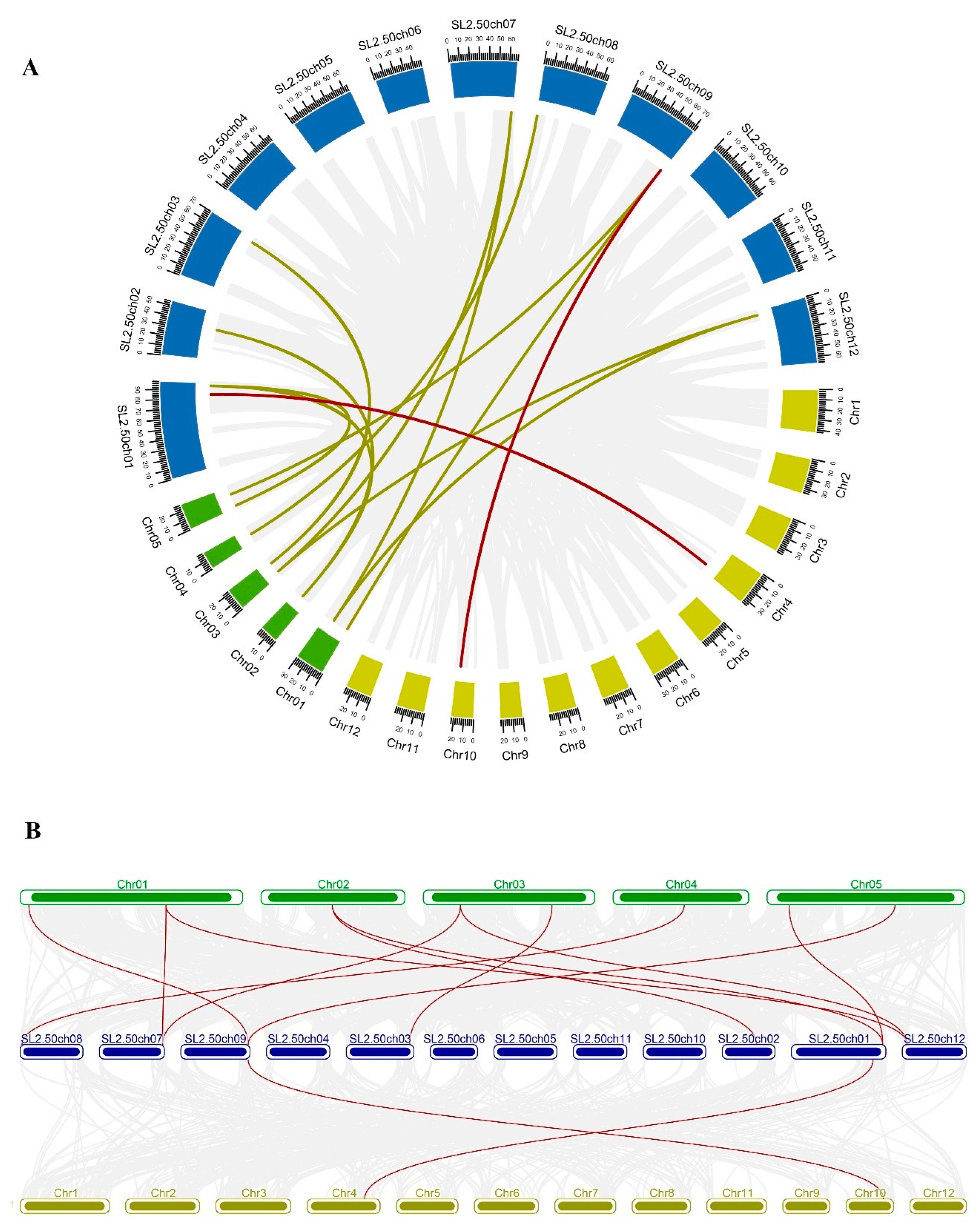
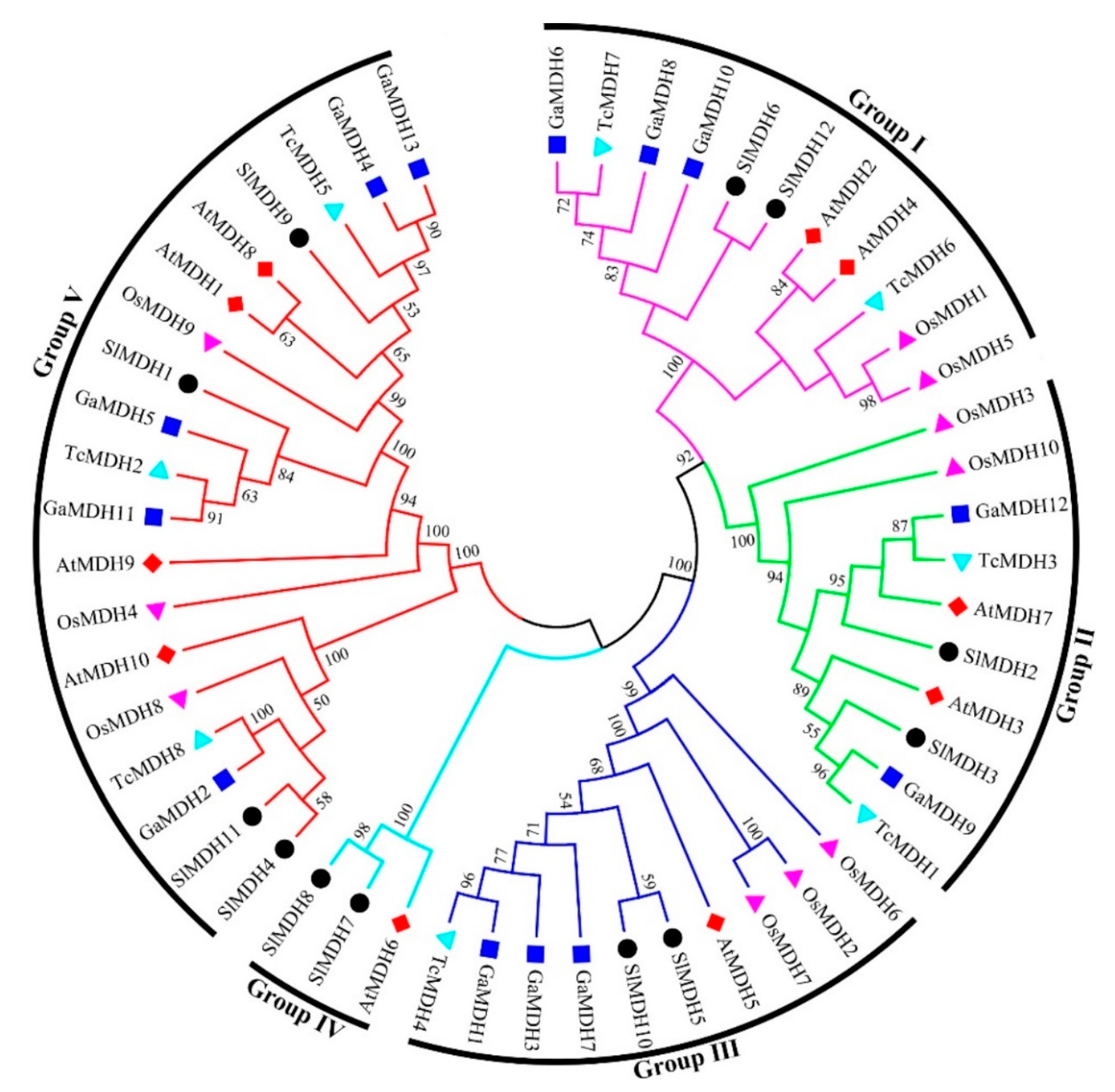
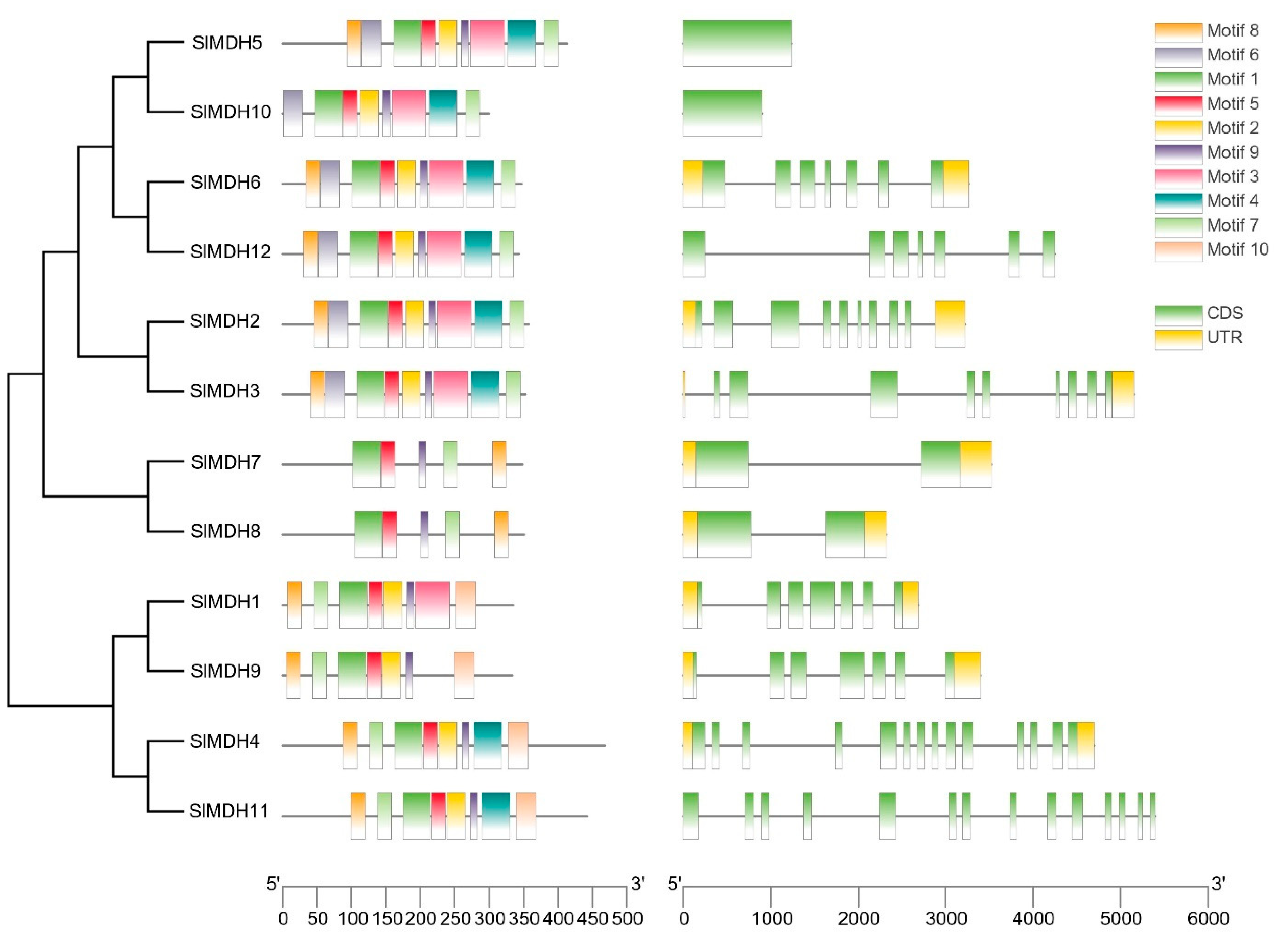
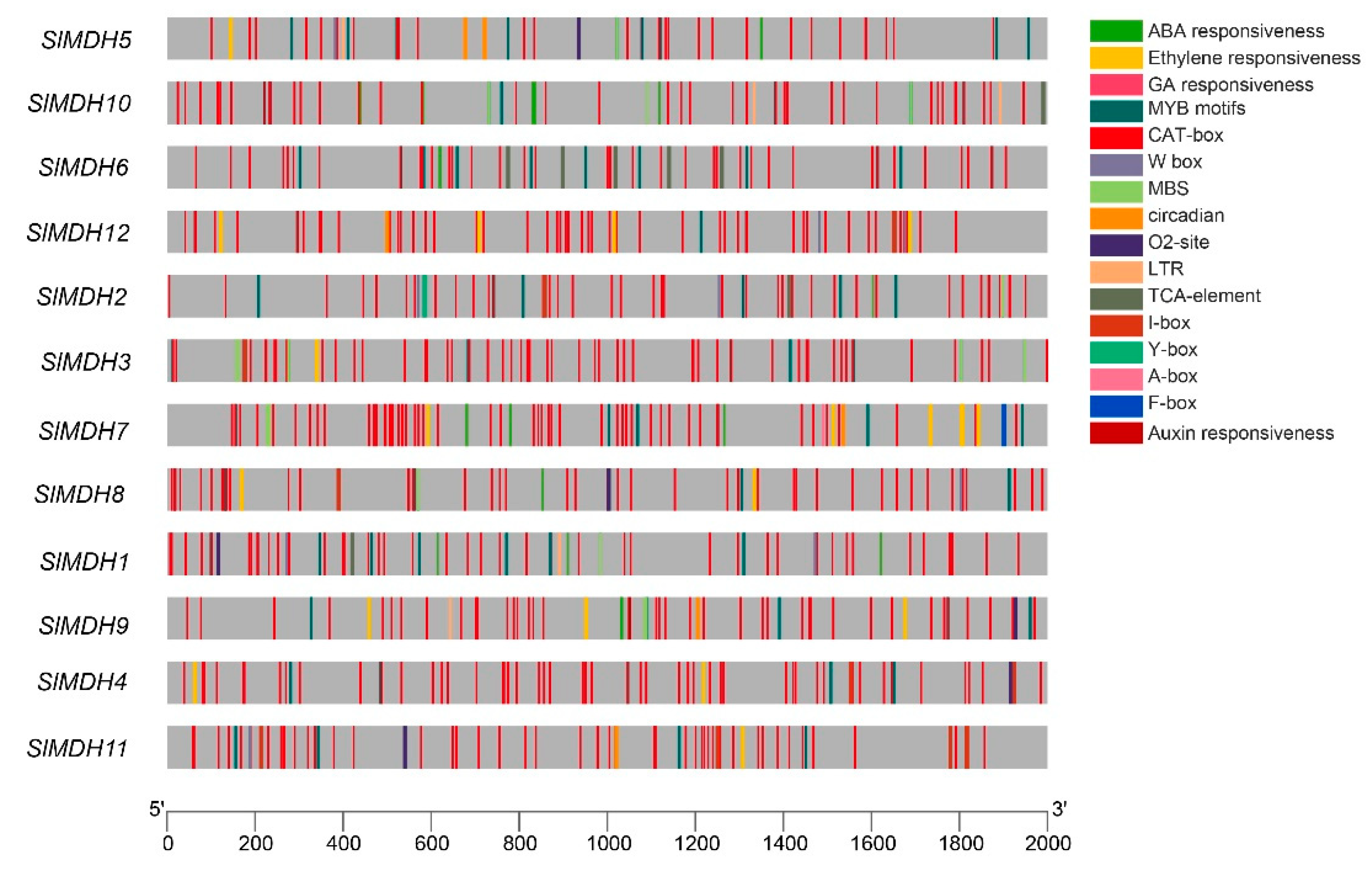
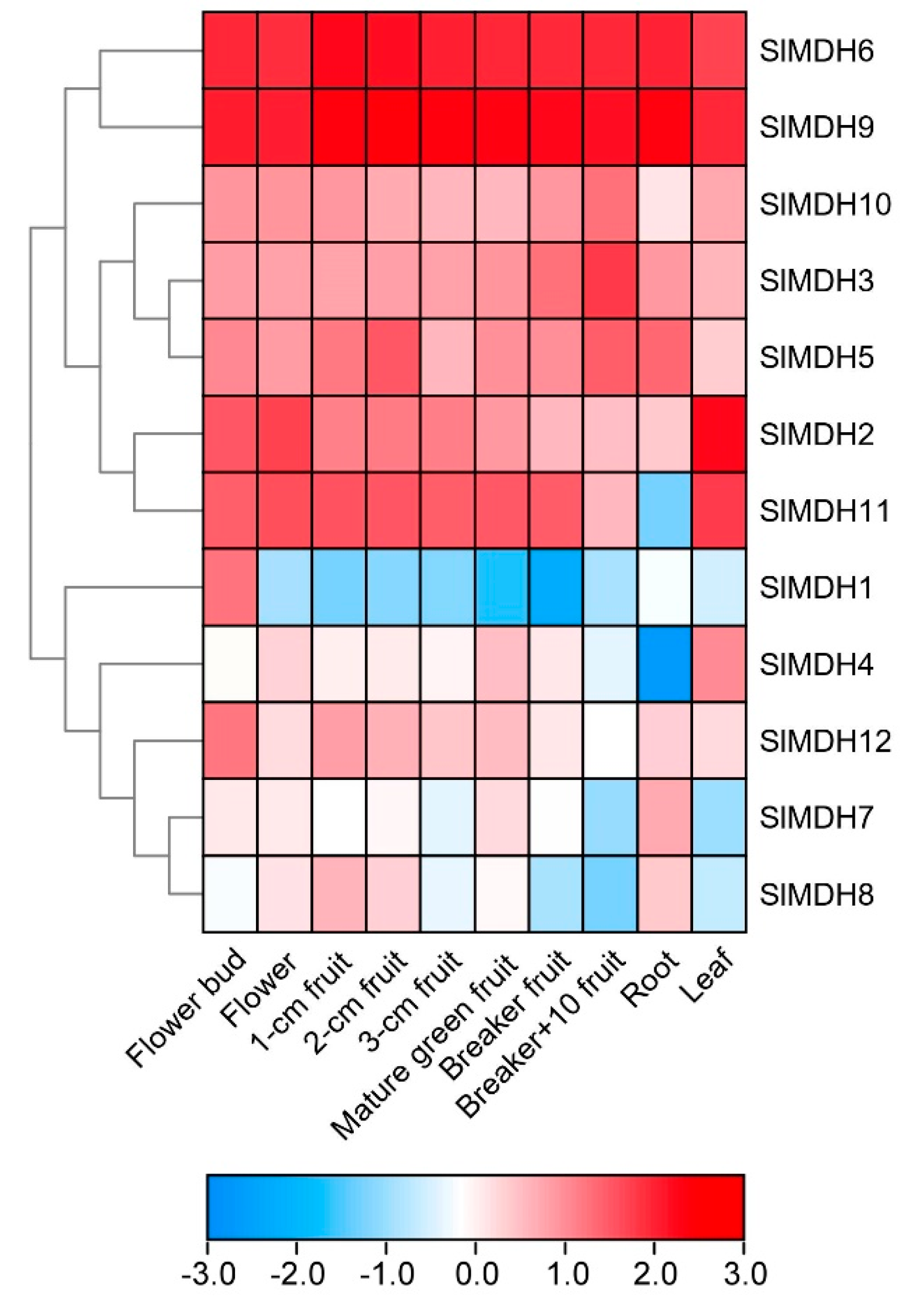
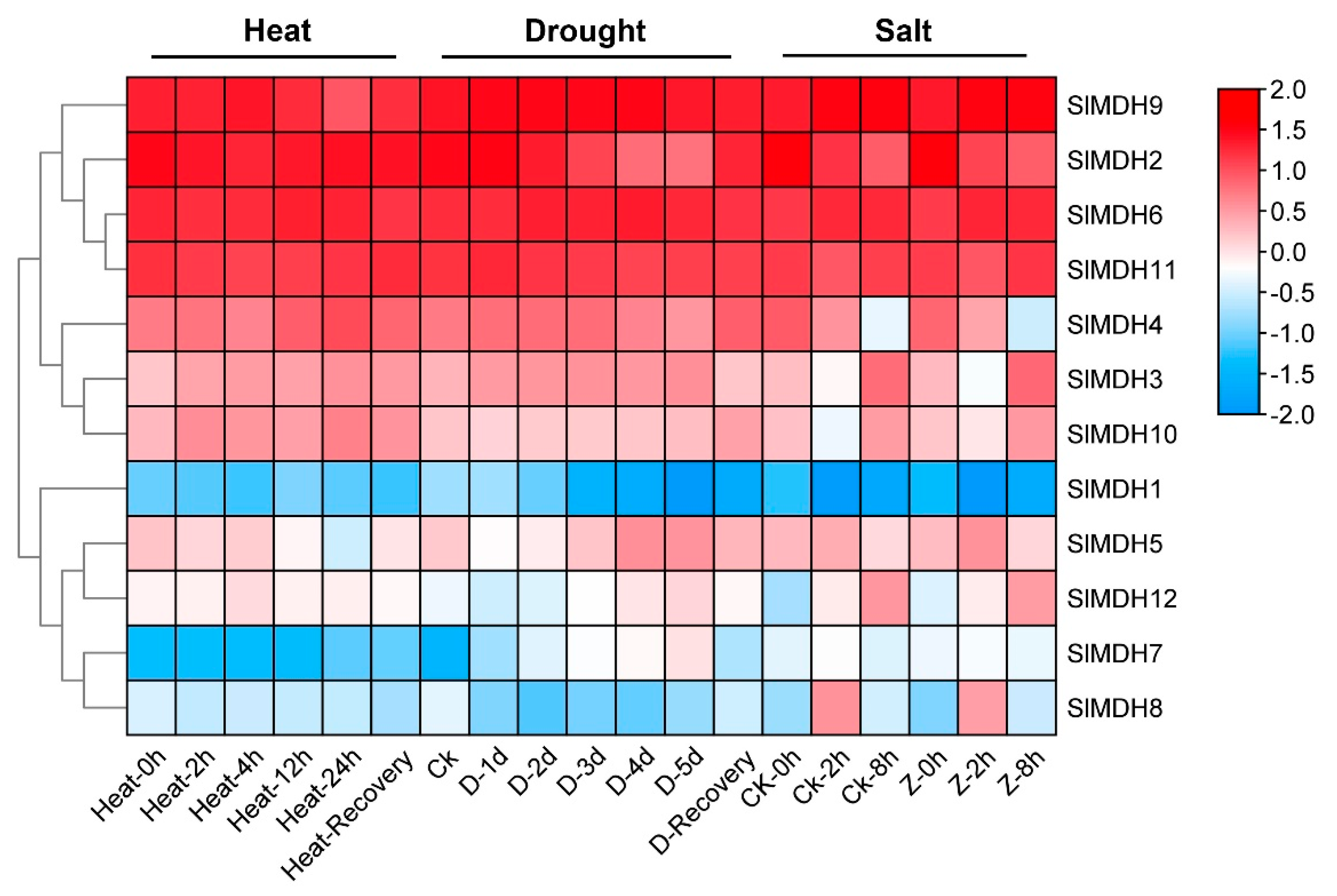
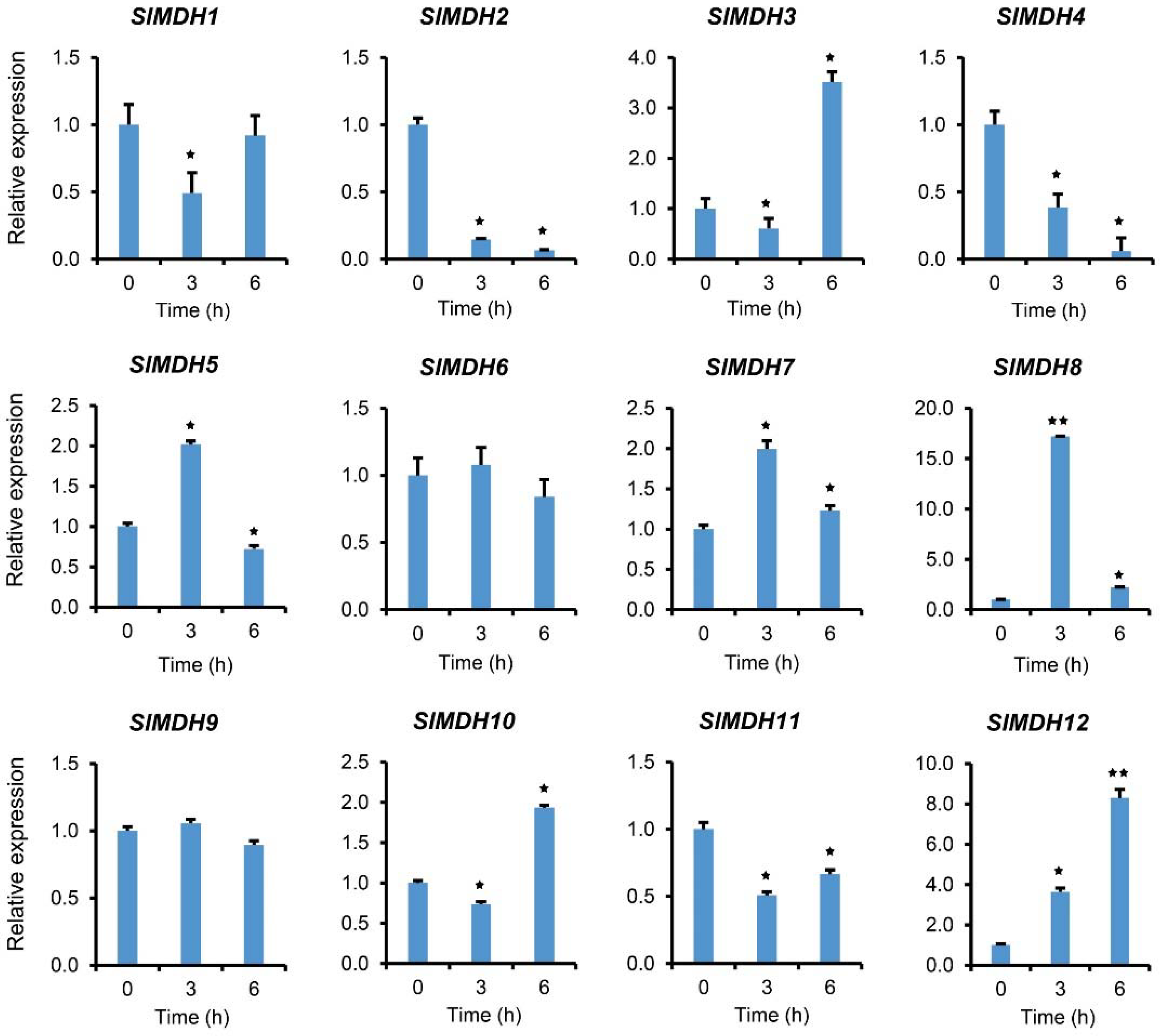
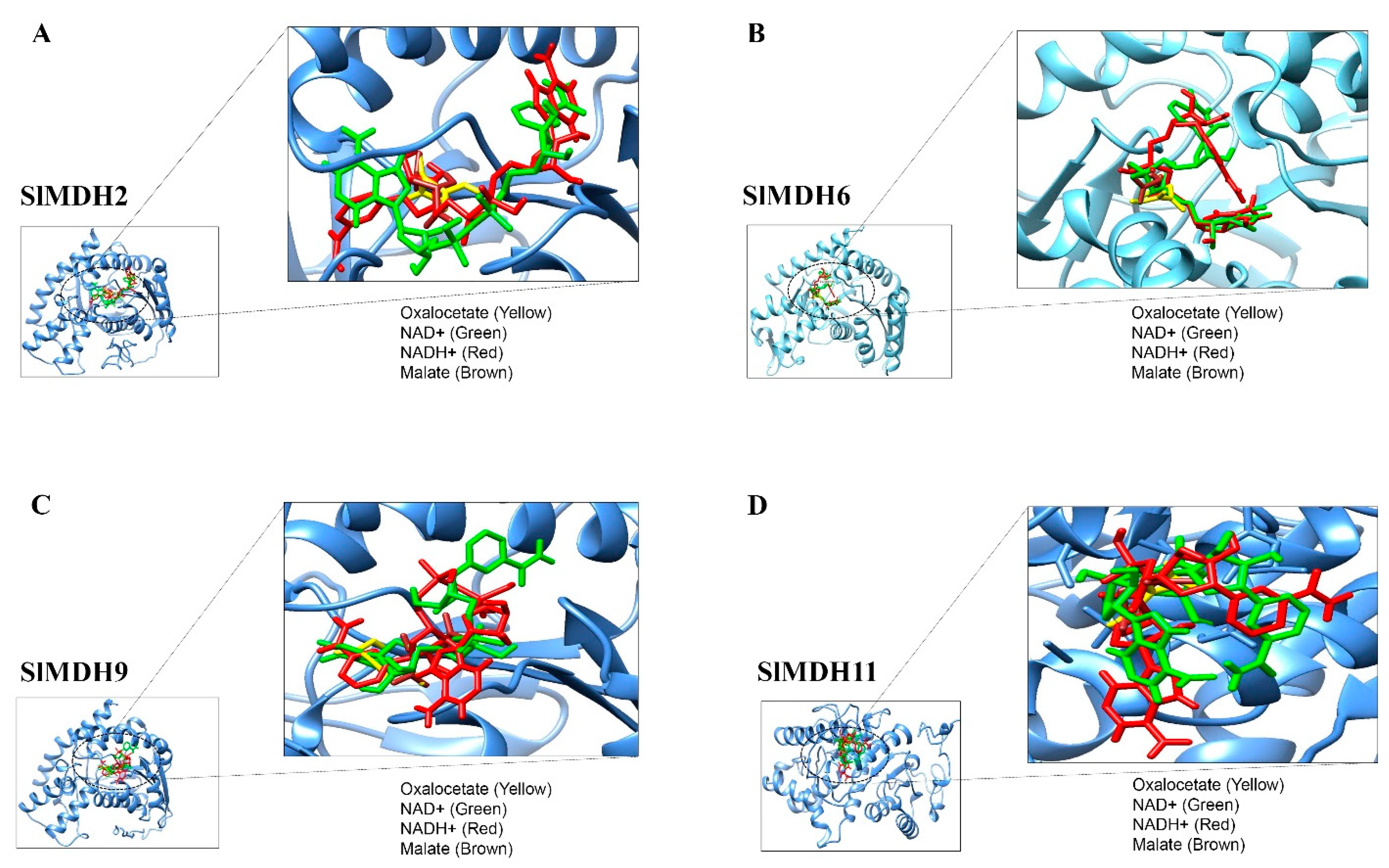
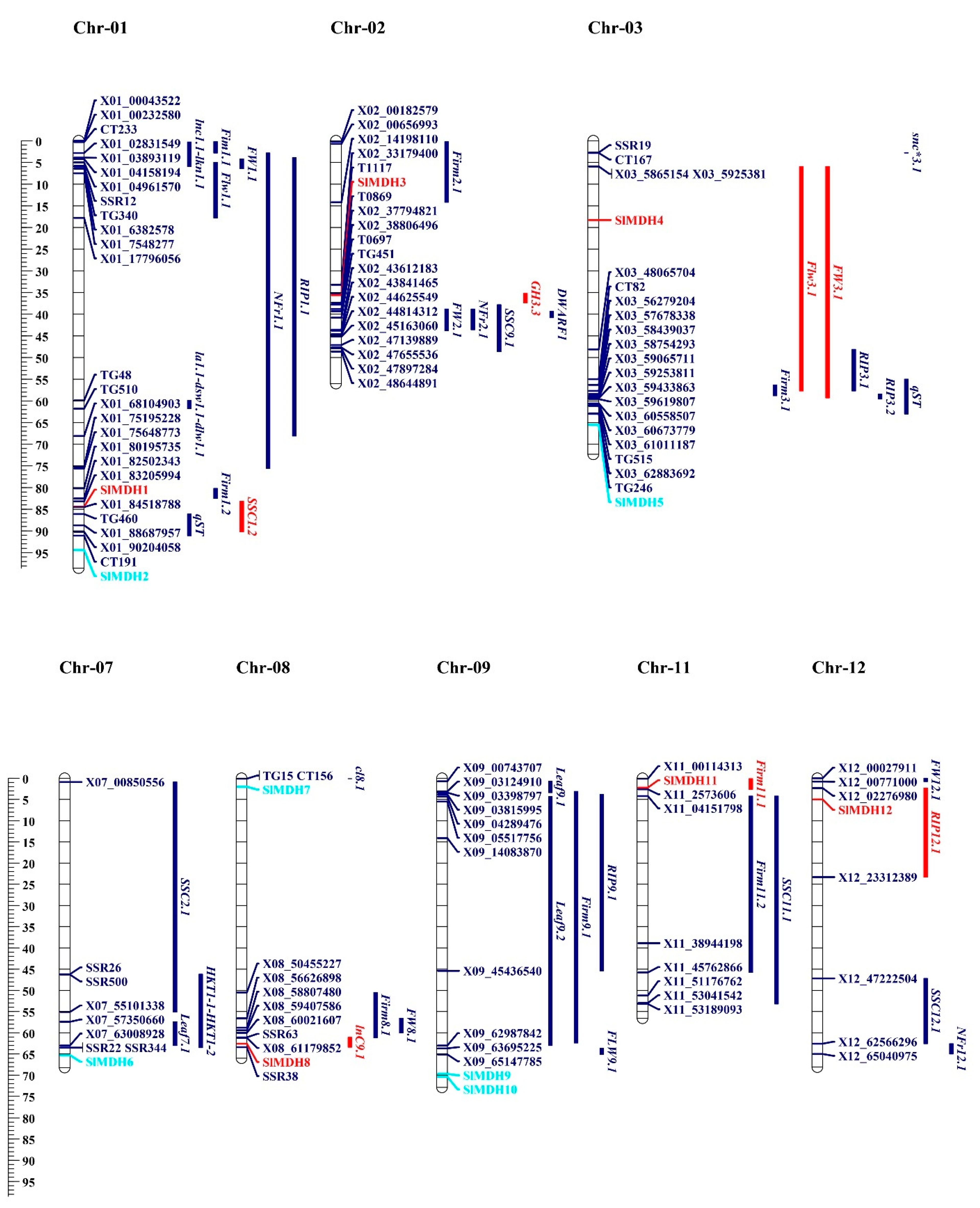
| Gene ID | Gene Name | Genome Positioin | CDS | Size (aa) | MW (kDa) | pI | Subcellular Localization |
|---|---|---|---|---|---|---|---|
| Solyc01g090710.2.1.ITAG2.4 | SlMDH1 | ch01:84349916..84352603 forward | 1005 | 334 | 35.88 | 6.46 | Cytoplasmic |
| Solyc01g106480.2.1.ITAG2.4 | SlMDH2 | ch01:94360820..94364041 reverse | 1074 | 357 | 37.63 | 8.1 | Glyoxysomal |
| Solyc02g063490.2.1.ITAG2.4 | SlMDH3 | ch02:35565021..35570176 reverse | 1059 | 352 | 36.85 | 8.13 | Chloroplast |
| Solyc03g071590.2.1.ITAG2.4 | SlMDH4 | ch03:18254318..18259019 reverse | 1404 | 467 | 51.66 | 7.89 | Chloroplast |
| Solyc03g115990.1.1.ITAG2.4 | SlMDH5 | ch03:65541129..65542368 forward | 1239 | 412 | 43.19 | 8.34 | Chloroplast |
| Solyc07g062650.2.1.ITAG2.4 | SlMDH6 | ch07:65338276..65341542 forward | 1041 | 346 | 36.08 | 8.73 | Mitochondrial |
| Solyc08g007420.2.1.ITAG2.4 | SlMDH7 | ch08:1979674..1983199 forward | 1044 | 347 | 37.64 | 5.36 | Cytoplasmic |
| Solyc08g078850.2.1.ITAG2.4 | SlMDH8 | ch08:62549883..62552206 forward | 1053 | 350 | 37.7 | 6.31 | Chloroplast |
| Solyc09g090140.2.1.ITAG2.4 | SlMDH9 | ch09:69683418..69686815 reverse | 999 | 332 | 35.38 | 5.91 | Cytoplasmic |
| Solyc09g091070.1.1.ITAG2.4 | SlMDH10 | ch09:70406056..70406953 forward | 897 | 298 | 31.81 | 5.35 | Cytoplasmic |
| Solyc11g007990.1.1.ITAG2.4 | SlMDH11 | ch11:2198504..2203902 forward | 1329 | 442 | 48.44 | 6.23 | Chloroplast |
| Solyc12g014180.1.1.ITAG2.4 | SlMDH12 | ch12:5027816..5032069 reverse | 1029 | 342 | 35.65 | 8.9 | Mitochondrial |
| Complex | Binding Affinity (kcal/mol) | No. of Hydrogen Bond | Interacting Residues |
|---|---|---|---|
| SIMDH11 Docking Results | |||
| SIMDH11 with Oxaloacetate | −3.7 | A: Asp198–UNK: O A: Cys418–UNK: OH A: His421–UNK: O | Cys418, Asp198, Gly195 |
| SIMDH11 with NAD+. | −3.9 | A: Gln202–UNK: O A: Gly195–UNK: O | Leu197, Ala428, Gln202, Cys430 |
| SIMDH11 with Malate. | −3.7 | A: His421–UNK: O A: His421–UNK: OH A: Cys418–UNK: O A: Cys418–UNK: OH A: Asp198–UNK: O | Ala428, Cys418, Ala194, Gly195, Leu197 |
| SIMDH11 with NADH. | −7.5 | A: His421–UNK: O | Cyc430, Glu192, Leu197, Glu415, Arg417, Ile 199 |
| SIMDH6 Docking Results | |||
| SIMDH6 with Oxaloacetate | −4.6 | A: Gly232–UNK:O A: Arg163–UNK: O A: Arg163–UNK: O A: Gln192–UNK: O A: Asp160–UNK: OH A: His188–UNK: OH | Ile236, Gln229, Gln230, Ser189, Asp160 |
| SIMDH6 with NAD+. | −9.9 | A: Asn187–UNK: O A: Arg99–UNK: O A: Asn132–UNK: OH A: Asn32–UNK: OH A: Gln192–UNK: O A: His188–UNK: NH A: Arg163–UNK: O A: Ser242–UNK: O A: Val130–UNK: NH A: Val130–UNK: NH | Glu323, Arg99, Gln192, Ser242, Gly232, Pro133, Ala131, Val102, Leu159 |
| SIMDH6 with Malate. | −4.1 | A: Ala233–UNK: O A: Gly232–UNK: O A: Arg163–UNK: O A: Gln192–UNK: O | Gln230, Gly232, Ser189, Asp160, Ser190 |
| SIMDH11 with NADH. | −10 | A: Ser190–UNK: O A: Gln192–UNK: O A: Arg163–UNK: O A: Val130–UNK: NH A: Leu156–UNK: NH | Arg93, Gln192, Ser243, Val130, Lew159, Pro133, Ile236, Ile235, Asn132 |
| SIMDH2 Docking Results | |||
| SIMDH2 with Oxaloacetate | −4.7 | A: Asn138–UNK: O A: Asn163–UNK: O | Ala121, Gly122, Ile119, Asn163, Pro124 |
| SIMDH2 with NAD+. | −8.3 | A: Val79–UNK: O A: Met272–UNK: O A: Ile123–UNK: NH A: Ile123–UNK: NH | Tyr77, Gly52, Thr269, Ile161, Ile123, Arg125, Gly122, Ala121 |
| SIMDH2 with Malate. | −4.4 | A: Asn138–UNK: O | Gly122, Asn163, Ile57, Pro120, Thr269, Asn138 |
| SIMDH2 with NADH. | −8.3 | A: Asn163–UNK: O A: Ile57–UNK: O A: Gly56–UNK: O A: Asp78–UNK: O | Leu193, Ala268, Asn138, Pro120, Thr269, Tyr77, Asp78, Asn163 |
| SIMDH9 Docking Results | |||
| SIMDH9 with Oxaloacetate | −4.7 | A: Ile45–UNK: O A: Ile45–UNK: O A: Gly46–UNK: O A: Gly110–UNK: O A: Pro108–UNK: OH | Gly44. Pro112, Ser255, Pro108, Gly110, Gly46, Ile45 |
| SIMDH9 with NAD+. | −8.3 | A: Gly110–UNK: OH A: Ile45–UNK: O A: Ile149–UNK: NH | Tyr65, Gly110, Asp66, Gly43, Ile45, Pro112, Val111, Ile149, Ile129 |
| SIMDH9 with Malate | −4.2 | A: Ile145–UNK: O A: Gly46–UNK: O A: Ile149–UNK: NH A: Ile149–UNK: NH | Gly46, Gly43, Ala109, Gly110, Ala109 |
| SIMDH9 with NADH | −8.6 | A: Gly40–UNK: OH A: Gly43–UNK: OH A: Asp66–UNK: OH A: Ile67–UNK: O | Gly40, Asp66, Val111, Ala109, Pro108, Pro112, Ala42 |
Publisher’s Note: MDPI stays neutral with regard to jurisdictional claims in published maps and institutional affiliations. |
© 2022 by the authors. Licensee MDPI, Basel, Switzerland. This article is an open access article distributed under the terms and conditions of the Creative Commons Attribution (CC BY) license (https://creativecommons.org/licenses/by/4.0/).
Share and Cite
Imran, M.; Munir, M.Z.; Ialhi, S.; Abbas, F.; Younus, M.; Ahmad, S.; Naeem, M.K.; Waseem, M.; Iqbal, A.; Gul, S.; et al. Identification and Characterization of Malate Dehydrogenases in Tomato (Solanum lycopersicum L.). Int. J. Mol. Sci. 2022, 23, 10028. https://doi.org/10.3390/ijms231710028
Imran M, Munir MZ, Ialhi S, Abbas F, Younus M, Ahmad S, Naeem MK, Waseem M, Iqbal A, Gul S, et al. Identification and Characterization of Malate Dehydrogenases in Tomato (Solanum lycopersicum L.). International Journal of Molecular Sciences. 2022; 23(17):10028. https://doi.org/10.3390/ijms231710028
Chicago/Turabian StyleImran, Muhammad, Muhammad Zeeshan Munir, Sara Ialhi, Farhat Abbas, Muhammad Younus, Sajjad Ahmad, Muhmmad Kashif Naeem, Muhammad Waseem, Arshad Iqbal, Sanober Gul, and et al. 2022. "Identification and Characterization of Malate Dehydrogenases in Tomato (Solanum lycopersicum L.)" International Journal of Molecular Sciences 23, no. 17: 10028. https://doi.org/10.3390/ijms231710028
APA StyleImran, M., Munir, M. Z., Ialhi, S., Abbas, F., Younus, M., Ahmad, S., Naeem, M. K., Waseem, M., Iqbal, A., Gul, S., Widemann, E., & Shafiq, S. (2022). Identification and Characterization of Malate Dehydrogenases in Tomato (Solanum lycopersicum L.). International Journal of Molecular Sciences, 23(17), 10028. https://doi.org/10.3390/ijms231710028











